Assessing the Impact of Climate and Human Activities on Ecosystem Services in the Loess Plateau Ecological Screen, China
Abstract
:1. Introduction
2. Study Area and Materials
2.1. Study Area
2.2. Data Source
3. Methods
3.1. Ecosystem Services Valuation
3.1.1. Sand-Stabilization Service
3.1.2. Soil Conservation Service
3.1.3. Water Conservation Service
3.1.4. Carbon Sequestration Service
3.1.5. Habitat Provision
- ①
- site quality
- ②
- habitat scarcity
3.2. Ecosystem Services Trade-Offs and Synergies
3.3. Construction of an Evaluation System for Assessing the Impact of Human Activities
3.4. Path Analysis
4. Results
4.1. Trends in ES on the Loess Plateau Ecological Screen from 2000 to 2020
4.2. Ecosystem Service Trade-Offs and Synergies
4.3. Ecosystem Services Impact Factor
4.4. Ecosystem Service Trade-Offs Impact Factor
4.5. Ecosystem Services Synergies Impact Factor
5. Discussion
5.1. Analysis of the Individual Drivers of Ecosystem Services
5.2. Contribution of the Research
5.3. Uncertainties and Limitations
6. Conclusions
- 1.
- The increasing trend of ecosystem services: Over the 20-year period, all five ecosystem services (ES) showed an increase. Carbon sequestration service (C), water conservation service (WCS), habitat provision (HP), soil conservation service (SCS), and sand-stabilization service (SSS) experienced growth rates of 39.4%, 36.4%, 23.5%, 6.9%, and 5.6%, respectively.
- 2.
- Synergies and trade-offs among ES: Significant synergies were observed between HP and SSS, indicating that these two ES tend to positively influence each other. On the other hand, trade-offs were dominant between WCS and C, suggesting that enhancing one of these services could potentially lead to a decline in the other. WCS and SSS exhibited a large area of uncorrelatedness, indicating that changes in one service had little impact on the other. The relationships between other ES varied with a mixture of synergies and trade-offs.
- 3.
- The influence of environmental factors: Precipitation emerged as the main driver of synergies and trade-offs among different ES, indicating that changes in precipitation levels significantly influenced the interactions between ES. Among them, precipitation had the highest coefficient of influence on SCS, which is 0.726. The human activities factor, which we are more concerned about, had the greatest influence on HP, with a path coefficient of 0.262. Temperature, on the other hand, had an inhibitory effect on ES. In specific relationships, such as HP and C, C and WCS, and HP and SSS, temperature played a prominent inhibitory role. Furthermore, human activities were found to have a primary control over WCS, exerting a greater influence on the synergies and trade-offs between WCS and other ES.
- 4.
- The effects of environmental gradients: This study highlights that single factors exhibit varying effects on ES at different environmental gradients, including anthropogenic gradients. High altitude and high fractional vegetation cover (FVC) were found to contribute significantly to WCS.
Author Contributions
Funding
Data Availability Statement
Conflicts of Interest
References
- Costanza, R.; d’Arge, R.; de Groot, R.; Farber, S.; Grasso, M.; Hannon, B.; Limburg, K.; Naeem, S.; Oneill, R.V.; Paruelo, J.; et al. The value of the world’s ecosystem services and natural capital. Nature 1997, 387, 253–260. [Google Scholar] [CrossRef]
- Berry, Z.C.; Jones, K.W.; Aguilar, L.R.G.; Congalton, R.G.; Holwerda, F.; Kolka, R.; Looker, N.; Ramirez, S.M.L.; Manson, R.; Mayer, A.; et al. Evaluating ecosystem service trade-offs along a land-use intensification gradient in central Veracruz, Mexico. Ecosyst. Serv. 2020, 45, 101181. [Google Scholar] [CrossRef]
- Belaire, J.A.; Higgins, C.; Zoll, D.; Lieberknecht, K.; Bixler, R.P.; Neff, J.L.; Keitt, T.H.; Jha, S. Fine-scale monitoring and mapping of biodiversity and ecosystem services reveals multiple synergies and few tradeoffs in urban green space management. Sci. Total Environ. 2022, 849, 157801. [Google Scholar] [CrossRef]
- Li, S.; Xie, A.; Lyu, C.; Guo, X. Research Progress and Prospect for Land Ecosystem Services. China Land Sci. 2018, 32, 82–89. [Google Scholar]
- Hasan, S.S.; Zhen, L.; Miah, M.G.; Ahamed, T.; Samie, A. Impact of land use change on ecosystem services: A review. Environ. Dev. 2020, 34, 100527. [Google Scholar] [CrossRef]
- Fu, B.; Zhang, L. Land-use change and ecosystem services: Concepts, methods and progress. Prog. Geogr. 2014, 33, 441–446. [Google Scholar]
- Huang, C.; Yang, J.; Zhang, W. Development of ecosystem services evaluation models: Research progress. Chin. J. Ecol. 2013, 32, 3360–3367. [Google Scholar]
- Bagstad, K.J.; Johnson, G.W.; Voigt, B.; Villa, F. Spatial dynamics of ecosystem service flows: A comprehensive approach to quantifying actual services. Ecosyst. Serv. 2013, 4, 117–125. [Google Scholar] [CrossRef]
- Mace, G.M.; Norris, K.; Fitter, A.H. Biodiversity and ecosystem services: A multilayered relationship. Trends Ecol. Evol. 2012, 27, 19–26. [Google Scholar] [CrossRef]
- Haase, D.; Schwarz, N.; Strohbach, M.; Kroll, F.; Seppelt, R. Synergies, Trade-offs, and Losses of Ecosystem Services in Urban Regions: An Integrated Multiscale Framework Applied to the Leipzig-Halle Region, Germany. Ecol. Soc. 2012, 17, 1–22. [Google Scholar] [CrossRef]
- Wei, C.W.; Su, K.; Jiang, X.B.; You, Y.F.; Zhou, X.B.; Yu, Z.; Chen, Z.C.; Liao, Z.H.; Zhang, Y.M.; Wang, L.Y. Increase in precipitation and fractional vegetation cover promote synergy of ecosystem services in China’s arid regions-Northern sand-stabilization belt. Front. Ecol. Evol. 2023, 11, 1116484. [Google Scholar] [CrossRef]
- Su, K.; Liu, H.J.; Wang, H.Y. Spatial-Temporal Changes and Driving Force Analysis of Ecosystems in the Loess Plateau Ecological Screen. Forests 2022, 13, 54. [Google Scholar] [CrossRef]
- Wood, E.M.; Pidgeon, A.M. Extreme variations in spring temperature affect ecosystem regulating services provided by birds during migration. Ecosphere 2015, 6, 1–16. [Google Scholar] [CrossRef]
- Li, P.; Omani, N.; Chaubey, I.; Wei, X.M. Evaluation of Drought Implications on Ecosystem Services: Freshwater Provisioning and Food Provisioning in the Upper Mississippi River Basin. Int. J. Environ. Res. Public Health 2017, 14, 496. [Google Scholar] [CrossRef] [PubMed]
- Canelas, J.V.; Pereira, H.M. Impacts of land-use intensity on ecosystems stability. Ecol. Model. 2022, 472, 110093. [Google Scholar] [CrossRef]
- Balvanera, P.; Pfisterer, A.B.; Buchmann, N.; He, J.S.; Nakashizuka, T.; Raffaelli, D.; Schmid, B. Quantifying the evidence for biodiversity effects on ecosystem functioning and services. Ecol. Lett. 2006, 9, 1146–1156. [Google Scholar] [CrossRef] [PubMed]
- Allan, E.; Manning, P.; Alt, F.; Binkenstein, J.; Blaser, S.; Bluethgen, N.; Bohm, S.; Grassein, F.; Holzel, N.; Klaus, V.H.; et al. Land use intensification alters ecosystem multifunctionality via loss of biodiversity and changes to functional composition. Ecol. Lett. 2015, 18, 834–843. [Google Scholar] [CrossRef]
- Smale, D.A. Impacts of ocean warming on kelp forest ecosystems. New Phytol. 2020, 225, 1447–1454. [Google Scholar] [CrossRef]
- Nelson, G.C.; Bennett, E.; Berhe, A.A.; Cassman, K.; DeFries, R.; Dietz, T.; Dobermann, A.; Dobson, A.; Janetos, A.; Levy, M.; et al. Anthropogenic drivers of ecosystem change: An overview. Ecol. Soc. 2006, 11, 1–31. [Google Scholar] [CrossRef]
- Mayer, A.; Kaufmann, L.; Kalt, G.; Matej, S.; Theurl, M.C.; Morais, T.G.; Leip, A.; Erb, K.H. Applying the Human Appropriation of Net Primary Production framework to map provisioning ecosystem services and their relation to ecosystem functioning across the European Union. Ecosyst. Serv. 2021, 51, 101344. [Google Scholar] [CrossRef]
- Kumar, M.; Savita; Singh, H.; Pandey, R.; Singh, M.P.; Ravindranath, N.H.; Kalra, N. Assessing vulnerability of forest ecosystem in the Indian Western Himalayan region using trends of net primary productivity. Biodivers. Conserv. 2019, 28, 2163–2182. [Google Scholar] [CrossRef]
- Briner, S.; Huber, R.; Bebi, P.; Elkin, C.; Schmatz, D.R.; Gret-Regamey, A. Trade-Offs between Ecosystem Services in a Mountain Region. Ecol. Soc. 2013, 18, 35. [Google Scholar] [CrossRef]
- Aparecido, L.M.T.; Teodoro, G.S.; Mosquera, G.; Brum, M.; Barros, F.D.; Pompeu, P.V.; Rodas, M.; Lazo, P.; Muller, C.S.; Mulligan, M.; et al. Ecohydrological drivers of Neotropical vegetation in montane ecosystems. Ecohydrology 2018, 11, e1932. [Google Scholar] [CrossRef]
- Garcia-Llamas, P.; Geijzendorffer, I.R.; Garcia-Nieto, A.P.; Calvo, L.; Suarez-Seoane, S.; Cramer, W. Impact of land cover change on ecosystem service supply in mountain systems: A case study in the Cantabrian Mountains (NW of Spain). Reg. Environ. Chang. 2019, 19, 529–542. [Google Scholar] [CrossRef]
- Mahdavi, P.; Akhani, H.; Van der Maarel, E. Species Diversity and Life-Form Patterns in Steppe Vegetation along a 3000 m Altitudinal Gradient in the Alborz Mountains, Iran. Folia Geobot. 2013, 48, 7–22. [Google Scholar] [CrossRef]
- Yu, Y.Y.; Li, J.; Zhou, Z.X.; Ma, X.P.; Zhang, X.F. Response of multiple mountain ecosystem services on environmental gradients: How to respond, and where should be priority conservation? J. Clean. Prod. 2021, 278, 123264. [Google Scholar] [CrossRef]
- Liu, L.B.; Wang, Z.; Wang, Y.; Zhang, Y.T.; Shen, J.S.; Qin, D.H.; Li, S.C. Trade-off analyses of multiple mountain ecosystem services along elevation, vegetation cover and precipitation gradients: A case study in the Taihang Mountains. Ecol. Indic. 2019, 103, 94–104. [Google Scholar] [CrossRef]
- Becker, A.; Korner, C.; Brun, J.J.; Guisan, A.; Tappeiner, U. Ecological and land use studies along elevational gradients. Mt. Res. Dev. 2007, 27, 58–65. [Google Scholar] [CrossRef]
- Ma, S.; Qiao, Y.P.; Wang, L.J.; Zhang, J.C. Terrain gradient variations in ecosystem services of different vegetation types in mountainous regions: Vegetation resource conservation and sustainable development. For. Ecol. Manag. 2021, 482, 118856. [Google Scholar] [CrossRef]
- Gomes, L.C.; Bianchi, F.; Cardoso, I.M.; Fernandes, E.I.; Schulte, R.P.O. Land use change drives the spatio-temporal variation of ecosystem services and their interactions along an altitudinal gradient in Brazil. Landsc. Ecol. 2020, 35, 1571–1586. [Google Scholar] [CrossRef]
- Sundqvist, M.K.; Sanders, N.J.; Wardle, D.A. Community and Ecosystem Responses to Elevational Gradients: Processes, Mechanisms, and Insights for Global Change. Annu. Rev. Ecol. Evol. Syst. 2013, 44, 261–280. [Google Scholar] [CrossRef]
- Wu, J.H.; Wang, G.Z.; Chen, W.X.; Pan, S.P.; Zeng, J. Terrain gradient variations in the ecosystem services value of the Qinghai-Tibet Plateau, China. Glob. Ecol. Conserv. 2022, 34, e02008. [Google Scholar] [CrossRef]
- Canedoli, C.; Ferre, C.; Abu El Khair, D.; Comolli, R.; Liga, C.; Mazzucchelli, F.; Proietto, A.; Rota, N.; Colombo, G.; Bassano, B.; et al. Evaluation of ecosystem services in a protected mountain area: Soil organic carbon stock and biodiversity in alpine forests and grasslands. Ecosyst. Serv. 2020, 44, 101135. [Google Scholar] [CrossRef]
- Garca-Llorente, M.; Iniesta-Arandia, I.; Willaarts, B.A.; Harrison, P.A.; Berry, P.; Bayo, M.D.; Castro, A.J.; Montes, C.; Martin-Lopez, B. Biophysical and sociocultural factors underlying spatial trade-offs of ecosystem services in semiarid watersheds. Ecol. Soc. 2015, 20, 39. [Google Scholar] [CrossRef]
- Juerges, N.; Arts, B.; Masiero, M.; Hoogstra-Klein, M.; Borges, J.G.; Brodrechtova, Y.; Brukas, V.; Canadas, M.J.; Carvalho, P.O.; Corradini, G.; et al. Power analysis as a tool to analyse trade-offs between ecosystem services in forest management: A case study from nine European countries. Ecosyst. Serv. 2021, 49, 101290. [Google Scholar] [CrossRef]
- Pena, L.; Onaindia, M.; de Manuel, B.F.; Ametzaga-Arregi, I.; Casado-Arzuaga, I. Analysing the Synergies and Trade-Offs between Ecosystem Services to Reorient Land Use Planning in Metropolitan Bilbao (Northern Spain). Sustainability 2018, 10, 4376. [Google Scholar] [CrossRef]
- Wam, H.K.; Bunnefeld, N.; Clarke, N.; Hofstad, O. Conflicting interests of ecosystem services: Multi-criteria modelling and indirect evaluation of trade-offs between monetary and non-monetary measures. Ecosyst. Serv. 2016, 22, 280–288. [Google Scholar] [CrossRef]
- Lavorel, S.; Grigulis, K. How fundamental plant functional trait relationships scale-up to trade-offs and synergies in ecosystem services. J. Ecol. 2012, 100, 128–140. [Google Scholar] [CrossRef]
- Le Provost, G.; Schenk, N.V.; Penone, C.; Thiele, J.; Westphal, C.; Allan, E.; Ayasse, M.; Bluthgen, N.; Boeddinghaus, R.S.; Boesing, A.L.; et al. The supply of multiple ecosystem services requires biodiversity across spatial scales. Nat. Ecol. Evol. 2023, 7, 236–249. [Google Scholar] [CrossRef]
- Liang, W.; Fu, B.J.; Wang, S.; Zhang, W.B.; Jin, Z.; Feng, X.M.; Yan, J.W.; Liu, Y.; Zhou, S. Quantification of the ecosystem carrying capacity on China’s Loess Plateau. Ecol. Indic. 2019, 101, 192–202. [Google Scholar] [CrossRef]
- Hu, Y.; Ma, L.; Li, R.; Ke, Z.; Yang, J.; Liu, Z. Factor analysis of underground biomass in forest ecosystem on the Loess Plateau. Acta Ecol. Sin. 2021, 41, 8643–8653. [Google Scholar]
- Zhao, X.; Ma, P.; Li, W.; Du, Y. Spatiotemporal changes of supply and demand relationships of ecosystem services in the Loess Plateau. Acta Geogr. Sin. 2021, 76, 2780–2796. [Google Scholar]
- Wang, S.; Fu, B.; Wu, X.; Wang, Y. Dynamics and sustainability of social-ecological systems in the Loess Plateau. Resour. Sci. 2020, 42, 96–103. [Google Scholar] [CrossRef]
- Zhang, Y.M.; Su, K.; Jiang, X.B.; You, Y.F.; Zhou, X.B.; Yu, Z.; Chen, Z.C.; Wang, L.Y.; Wei, C.W.; Liao, Z.H. Response of ecosystem services to impervious surface changes and their scaling effects in Loess Plateau ecological Screen, China. Ecol. Indic. 2023, 147, 109997. [Google Scholar] [CrossRef]
- Xu, K.J.; Tian, Q.J.; Yang, Y.J.; Yue, J.B.; Tang, S.F. How up-scaling of remote-sensing images affects land-cover classification by comparison with multiscale satellite images. Int. J. Remote Sens. 2019, 40, 2784–2810. [Google Scholar] [CrossRef]
- Wu, S.; Li, J.; Huang, G.H. A study on DEM-derived primary topographic attributes for hydrologic applications: Sensitivity to elevation data resolution. Appl. Geogr. 2008, 28, 210–223. [Google Scholar] [CrossRef]
- Zhang, H.Y.; Fan, J.W.; Cao, W.; Harris, W.; Li, Y.Z.; Chi, W.F.; Wang, S.Z. Response of wind erosion dynamics to climate change and human activity in Inner Mongolia, China during 1990 to 2015. Sci. Total Environ. 2018, 639, 1038–1050. [Google Scholar] [CrossRef] [PubMed]
- Xu, W.X.; Wang, J.M.; Zhang, M.; Li, S.J. Construction of landscape ecological network based on landscape ecological risk assessment in a large-scale opencast coal mine area. J. Clean. Prod. 2021, 286, 125523. [Google Scholar] [CrossRef]
- Pi, X.; Zeng, Y.; He, C. High-resolution urban vegetation coverage estimation based on multi-source remote sensing data fusion. J. Remote Sens. 2021, 25, 1216–1226. [Google Scholar] [CrossRef]
- Ma, Y.F.; Liu, S.M.; Song, L.S.; Xu, Z.W.; Liu, Y.L.; Xu, T.R.; Zhu, Z.L. Estimation of daily evapotranspiration and irrigation water efficiency at a Landsat-like scale for an arid irrigation area using multi-source remote sensing data. Remote Sens. Environ. 2018, 216, 715–734. [Google Scholar] [CrossRef]
- Luo, X.; Yang, J.; Sun, W.; He, B.J. Suitability of human settlements in mountainous areas from the perspective of ventilation: A case study of the main urban area of Chongqing. J. Clean. Prod. 2021, 310, 127467. [Google Scholar] [CrossRef]
- Fryrear, D.W.; Bilbro, J.D.; Saleh, A.; Schomberg, H.; Stout, J.E.; Zobeck, T.M. RWEQ: Improved wind erosion technology. J. Soil Water Conserv. 2000, 55, 183–189. [Google Scholar] [CrossRef]
- Guo, B.; Zhang, F.F.; Yang, G.; Sun, C.H.; Han, F.; Jiang, L. Improved estimation method of soil wind erosion based on remote sensing and geographic information system in the Xinjiang Uygur Autonomous Region, China. Geomat. Nat. Hazards Risk 2017, 8, 1752–1767. [Google Scholar] [CrossRef]
- Su, K.; Sun, X.T.; Guo, H.Q.; Long, Q.Q.; Li, S.; Mao, X.Q.; Niu, T.; Yu, Q.; Wang, Y.R.; Yue, D.P. The establishment of a cross-regional differentiated ecological compensation scheme based on the benefit areas and benefit levels of sand-stabilization ecosystem service. J. Clean. Prod. 2020, 270, 122490. [Google Scholar] [CrossRef]
- Gong, G.; Liu, J.; Shao, Q. Wind erosion in Xilingol League, Inner Mongolia since the 1990s using the Revised Wind Erosion Equation. Prog. Geogr. 2014, 33, 825–834. [Google Scholar]
- Thomsen, L.M.; Baartman, J.E.M.; Barneveld, R.J.; Starkloff, T.; Stolte, J. Soil surface roughness: Comparing old and new measuring methods and application in a soil erosion model. Soil 2015, 1, 399–410. [Google Scholar] [CrossRef]
- Saleh, A.; Fryear, D.W.; Bilbro, J.D. Aerodynamic roughness prediction from soil surface roughness measurement. Soil Sci. 1997, 162, 205–210. [Google Scholar] [CrossRef]
- Kong, L.Q.; Zheng, H.; Rao, E.M.; Xiao, Y.; Ouyang, Z.Y.; Li, C. Evaluating indirect and direct effects of eco-restoration policy on soil conservation service in Yangtze River Basin. Sci. Total Environ. 2018, 631–632, 887–894. [Google Scholar] [CrossRef]
- Pandey, A.; Chowdary, V.M.; Mal, B.C. Identification of critical erosion prone areas in the small agricultural watershed using USLE, GIS and remote sensing. Water Resour. Manag. 2007, 21, 729–746. [Google Scholar] [CrossRef]
- Zhang, W.; Xie, Y.; Liu, B. Rainfall Erosivity Estimation Using Daily Rainfall Amounts. Sci. Geogr. Sin. 2002, 22, 705–711. [Google Scholar]
- Bhuyan, S.J.; Kalita, P.K.; Janssen, K.A.; Barnes, P.L. Soil loss predictions with three erosion simulation models. Environ. Model. Softw. 2002, 17, 137–146. [Google Scholar] [CrossRef]
- Nearing, M.A. A single, continuous function for slope steepness influence on soil loss. Soil Sci. Soc. Am. J. 1997, 61, 917–919. [Google Scholar] [CrossRef]
- Fistikoglu, O.; Harmancioglu, N.B. Integration of GIS with USLE in assessment of soil erosion. Water Resour. Manag. 2002, 16, 447–467. [Google Scholar] [CrossRef]
- Zhang, L.; Dawes, W.R.; Walker, G.R. Response of mean annual evapotranspiration to vegetation changes at catchment scale. Water Resour. Res. 2001, 37, 701–708. [Google Scholar] [CrossRef]
- Piao, S.L.; Fang, J.Y.; Ciais, P.; Peylin, P.; Huang, Y.; Sitch, S.; Wang, T. The carbon balance of terrestrial ecosystems in China. Nature 2009, 458, 1009–1013. [Google Scholar] [CrossRef] [PubMed]
- Fang, J.Y.; Chen, A.P.; Peng, C.H.; Zhao, S.Q.; Ci, L. Changes in forest biomass carbon storage in China between 1949 and 1998. Science 2001, 292, 2320–2322. [Google Scholar] [CrossRef] [PubMed]
- Bryan, B.A.; Nolan, M.; Harwood, T.D.; Connor, J.D.; Navarro-Garcia, J.; King, D.; Summers, D.M.; Newth, D.; Cai, Y.; Grigg, N.; et al. Supply of carbon sequestration and biodiversity services from Australia’s agricultural land under global change. Glob. Environ. Chang. Hum. Policy Dimens. 2014, 28, 166–181. [Google Scholar] [CrossRef]
- Huang, L.; Liu, J.; Shao, Q.; Deng, X. Temporal and spatial patterns of carbon sequestration services for primary terrestrial ecosystems in China between 1990 and 2030. Acta Ecol. Sin. 2016, 36, 3891–3902. [Google Scholar]
- Liu, W.; Yan, Y.; Wang, D.; Ma, W. Integrate carbon dynamics models for assessing the impact of land use intervention on carbon sequestration ecosystem service. Ecol. Indic. 2018, 91, 268–277. [Google Scholar] [CrossRef]
- Ruijs, A.; Wossink, A.; Kortelainen, M.; Alkemade, R.; Schulp, C.J.E. Trade-off analysis of ecosystem services in Eastern Europe. Ecosyst. Serv. 2013, 4, 82–94. [Google Scholar] [CrossRef]
- Zhai, T.; Wang, J.; Fang, Y.; Huang, L.; Liu, J.; Zhao, C. Integrating Ecosystem Services Supply, Demand and Flow in Ecological Compensation: A Case Study of Carbon Sequestration Services. Sustainability 2021, 13, 1668. [Google Scholar] [CrossRef]
- Wu, L.L.; Sun, C.G.; Fan, F.L. Estimating the Characteristic Spatiotemporal Variation in Habitat Quality Using the InVEST Model-A Case Study from Guangdong-Hong Kong-Macao Greater Bay Area. Remote Sens. 2021, 13, 1008. [Google Scholar] [CrossRef]
- Aneseyee, A.B.; Noszczyk, T.; Soromessa, T.; Elias, E. The InVEST Habitat Quality Model Associated with Land Use/Cover Changes: A Qualitative Case Study of the Winike Watershed in the Omo-Gibe Basin, Southwest Ethiopia. Remote Sens. 2020, 12, 1103. [Google Scholar] [CrossRef]
- Alamgir, M.; Turton, S.M.; Macgregor, C.J.; Pert, P.L. Ecosystem services capacity across heterogeneous forest types: Understanding the interactions and suggesting pathways for sustaining multiple ecosystem services. Sci. Total Environ. 2016, 566, 584–595. [Google Scholar] [CrossRef] [PubMed]
- Brockerhoff, E.G.; Barbaro, L.; Castagneyrol, B.; Forrester, D.I.; Gardiner, B.; Gonzalez-Olabarria, J.R.; Lyver, P.O.; Meurisse, N.; Oxbrough, A.; Taki, H.; et al. Forest biodiversity, ecosystem functioning and the provision of ecosystem services. Biodivers. Conserv. 2017, 26, 3005–3035. [Google Scholar] [CrossRef]
- Dobson, A.; Lodge, D.; Alder, J.; Cumming, G.S.; Keymer, J.; McGlade, J.; Mooney, H.; Rusak, J.A.; Sala, O.; Wolters, V.; et al. Habitat loss, trophic collapse, and the decline of ecosystem services. Ecology 2006, 87, 1915–1924. [Google Scholar] [CrossRef] [PubMed]
- Nelson, E.; Sander, H.; Hawthorne, P.; Conte, M.; Ennaanay, D.; Wolny, S.; Manson, S.; Polasky, S. Projecting Global Land-Use Change and Its Effect on Ecosystem Service Provision and Biodiversity with Simple Models. PLoS ONE 2010, 5, e14327. [Google Scholar] [CrossRef]
- Ouyang, Z.; Zheng, H.; Xiao, Y.; Polasky, S.; Liu, J.; Xu, W.; Wang, Q.; Zhang, L.; Xiao, Y.; Rao, E.; et al. Improvements in ecosystem services from investments in natural capital. Science 2016, 352, 1455–1459. [Google Scholar] [CrossRef]
- Terrado, M.; Sabater, S.; Chaplin-Kramer, B.; Mandle, L.; Ziv, G.; Acuna, V. Model development for the assessment of terrestrial and aquatic habitat quality in conservation planning. Sci. Total Environ. 2016, 540, 63–70. [Google Scholar] [CrossRef]
- Bhagabati, N.K.; Ricketts, T.; Sulistyawan, T.B.S.; Conte, M.; Ennaanay, D.; Hadian, O.; McKenzie, E.; Olwero, N.; Rosenthal, A.; Tallis, H.; et al. Ecosystem services reinforce Sumatran tiger conservation in land use plans. Biol. Conserv. 2014, 169, 147–156. [Google Scholar] [CrossRef]
- Bennett, E.M.; Peterson, G.D.; Gordon, L.J. Understanding relationships among multiple ecosystem services. Ecol. Lett. 2009, 12, 1394–1404. [Google Scholar] [CrossRef] [PubMed]
- Rodriguez, J.P.; Beard, T.D.; Bennett, E.M.; Cumming, G.S.; Cork, S.J.; Agard, J.; Dobson, A.P.; Peterson, G.D. Trade-offs across space, time, and ecosystem services. Ecol. Soc. 2006, 11, 1–14. [Google Scholar] [CrossRef]
- Turner, K.G.; Odgaard, M.V.; Bocher, P.K.; Dalgaard, T.; Svenning, J.-C. Bundling ecosystem services in Denmark: Trade-offs and synergies in a cultural landscape. Landsc. Urban Plan. 2014, 125, 89–104. [Google Scholar] [CrossRef]
- Spake, R.; Lasseur, R.; Crouzat, E.; Bullock, J.M.; Lavorel, S.; Parks, K.E.; Schaafsma, M.; Bennett, E.M.; Maes, J.; Mulligan, M.; et al. Unpacking ecosystem service bundles: Towards predictive mapping of synergies and trade-offs between ecosystem services. Glob. Environ. Chang. Hum. Policy Dimens. 2017, 47, 37–50. [Google Scholar] [CrossRef]
- Howe, C.; Suich, H.; Vira, B.; Mace, G.M. Creating win-wins from trade-offs? Ecosystem services for human well-being: A meta-analysis of ecosystem service trade-offs and synergies in the real world. Glob. Environ. Chang. Hum. Policy Dimens. 2014, 28, 263–275. [Google Scholar] [CrossRef]
- Schober, P.; Boer, C.; Schwarte, L.A. Correlation Coefficients: Appropriate Use and Interpretation. Anesth. Analg. 2018, 126, 1763–1768. [Google Scholar] [CrossRef] [PubMed]
- Smith, P.; House, J.I.; Bustamante, M.; Sobocka, J.; Harper, R.; Pan, G.; West, P.C.; Clark, J.M.; Adhya, T.; Rumpel, C.; et al. Global change pressures on soils from land use and management. Glob. Chang. Biol. 2016, 22, 1008–1028. [Google Scholar] [CrossRef]
- Isbell, F.; Gonzalez, A.; Loreau, M.; Cowles, J.; Diaz, S.; Hector, A.; Mace, G.M.; Wardle, D.A.; O’Connor, M.I.; Duffy, J.E.; et al. Linking the influence and dependence of people on biodiversity across scales. Nature 2017, 546, 65–72. [Google Scholar] [CrossRef]
- Chagnon, M.; Kreutzweiser, D.; Mitchell, E.A.; Mitchell, E.A.; Morrissey, C.A.; Noome, D.A.; Noome, D.A.; Van der Sluijs, J.P.; Van der Sluijs, J.P. Risks of large-scale use of systemic insecticides to ecosystem functioning and services. Environ. Sci. Pollut. Res. 2015, 22, 119–134. [Google Scholar] [CrossRef]
- Fischer, A.; Eastwood, A. Coproduction of ecosystem services as human-nature interactions-An analytical framework. Land Use Policy 2016, 52, 41–50. [Google Scholar] [CrossRef]
- Fang, L.; Wang, L.; Chen, W.; Sun, J.; Cao, Q.; Wang, S.; Wang, L. Identifying the impacts of natural and human factors on ecosystem service in the Yangtze and Yellow River Basins. J. Clean. Prod. 2021, 314, 127995. [Google Scholar] [CrossRef]
- Burkhard, B.; Kroll, F.; Nedkov, S.; Mueller, F. Mapping ecosystem service supply, demand and budgets. Ecol. Indic. 2012, 21, 17–29. [Google Scholar] [CrossRef]
- Yang, B.; Wang, Z.; Zhang, H.; Tan, L. Spatial pattern evolution characteristics and driving mechanism of rural settlements in high mountain areas with poverty. Trans. Chin. Soc. Agric. Eng. 2021, 37, 285–293. [Google Scholar]
- Seto, K.C.; Fragkias, M.; Guneralp, B.; Reilly, M.K. A Meta-Analysis of Global Urban Land Expansion. PLoS ONE 2011, 6, e23777. [Google Scholar] [CrossRef]
- Carr, D. Population and deforestation: Why rural migration matters. Prog. Hum. Geogr. 2009, 33, 355–378. [Google Scholar] [CrossRef]
- Zheng, F.; Tang, K.; Bai, H. Study on Relationship between Human’s Activities and Environmental evolution. Res. Soil Water Conserv. 1994, 1, 36–42. [Google Scholar]
- Yang, Z.; Dong, J.; Xu, X.; Zhao, G.; Chen, W.; Zhou, Y. Spatiotemporal pattern of forest fragmentation in the Loess Plateau. Resour. Sci. 2018, 40, 1246–1255. [Google Scholar] [CrossRef]
- Wang, F.; Li, R.; Xie, Y. Analysis on Eco-environment Construction in Human Period on Loess Plateau. Res. Soil Water Conserv. 2001, 8, 138–142. [Google Scholar]
- Li, Q. Characteristics and development of grassland ecological environment on the northwestern loess plateau. Pratacultural Sci. 1998, 15, 1–8. [Google Scholar]
- Dijkstra, T.K.; Henseler, J. Consistent and asymptotically normal PLS estimators for linear structural equations. Comput. Stat. Data Anal. 2015, 81, 10–23. [Google Scholar] [CrossRef]
- You, Y.F.; Wang, S.Y.; Pan, N.Q.; Ma, Y.X.; Liu, W.H. Growth stage-dependent responses of carbon fixation process of alpine grasslands to climate change over the Tibetan Plateau, China. Agric. For. Meteorol. 2020, 291, 108085. [Google Scholar] [CrossRef]
- Gao, Y.H.; Zhou, X.; Wang, Q.; Wang, C.Z.; Zhan, Z.M.; Chen, L.F.; Yan, J.X.; Qu, R. Vegetation net primary productivity and its response to climate change during 2001–2008 in the Tibetan Plateau. Sci. Total Environ. 2013, 444, 356–362. [Google Scholar] [CrossRef] [PubMed]
- Li, Z.; Liu, Z.; Chen, Z.; Yang, Z. The effects of climate changes on the productivity in the Inner Mongolia steppe of China. Acta Prataculturae Sin. 2003, 12, 4–10. [Google Scholar]
- Mao, D.H.; Luo, L.; Wang, Z.M.; Zhang, C.H.; Ren, C.Y. Variations in net primary productivity and its relationships with warming climate in the permafrost zone of the Tibetan Plateau. J. Geogr. Sci. 2015, 25, 967–977. [Google Scholar] [CrossRef]
- Xu, M.H.; Zhao, Z.T.; Zhou, H.K.; Ma, L.; Liu, X.J. Plant Allometric Growth Enhanced by the Change in Soil Stoichiometric Characteristics with Depth in an Alpine Meadow Under Climate Warming. Front. Plant Sci. 2022, 13, 860980. [Google Scholar] [CrossRef] [PubMed]
- Zhu, X.; He, H.S.; Zhang, S.X.; Dijak, W.D.; Fu, Y.Y. Interactive Effects of Climatic Factors on Seasonal Vegetation Dynamics in the Central Loess Plateau, China. Forests 2019, 10, 1071. [Google Scholar] [CrossRef]
- Moura, M.R.; Villalobos, F.; Costa, G.C.; Garcia, P.C.A. Disentangling the Role of Climate, Topography and Vegetation in Species Richness Gradients. PLoS ONE 2016, 11, e152468. [Google Scholar] [CrossRef]
- Zhou, S.J.; Dong, Y.Q.; Julihaiti, A.; Nie, T.T.; Jiang, A.J.; An, S.Z. Spatial Variation in Desert Spring Vegetation Biomass, Richness and Their Environmental Controls in the Arid Region of Central Asia. Sustainability 2022, 14, 12152. [Google Scholar] [CrossRef]
- Zhang, H.Y.; Fan, J.W.; Cao, W.; Zhong, H.P.; Harris, W.; Gong, G.L.; Zhang, Y.X. Changes in multiple ecosystem services between 2000 and 2013 and their driving factors in the Grazing Withdrawal Program, China. Ecol. Eng. 2018, 116, 67–79. [Google Scholar] [CrossRef]
- Jia, X.X.; Shao, M.A.; Zhu, Y.J.; Luo, Y. Soil moisture decline due to afforestation across the Loess Plateau, China. J. Hydrol. 2017, 546, 113–122. [Google Scholar] [CrossRef]
- Feng, X.M.; Li, J.X.; Cheng, W.; Fu, B.J.; Wang, Y.Q.; Lu, Y.H.; Shao, M.A. Evaluation of AMSR-E retrieval by detecting soil moisture decrease following massive dryland re-vegetation in the Loess Plateau, China. Remote Sens. Environ. 2017, 196, 253–264. [Google Scholar] [CrossRef]
- Jing, P.Q.; Zhang, D.H.; Ai, Z.M.; Wu, H.J.; Zhang, D.M.; Ren, H.H.; Suo, L. Responses of Ecosystem Services to Climate Change: A Case Study of the Loess Plateau. Forests 2022, 13, 2011. [Google Scholar] [CrossRef]
- Zhang, H.D.; Wei, W.; Chen, L.D.; Yang, L. Evaluating canopy transpiration and water use of two typical planted tree species in the dryland Loess Plateau of China. Ecohydrology 2017, 10, e1830. [Google Scholar] [CrossRef]
- Urban, M.C. Accelerating extinction risk from climate change. Science 2015, 348, 571–573. [Google Scholar] [CrossRef] [PubMed]
- Bai, L.; Tian, J.L.; Peng, Y.; Huang, Y.H.; He, X.; Bai, X.Y.; Bai, T. Effects of climate change on ecosystem services and their components in southern hills and northern grasslands in China. Environ. Sci. Pollut. Res. 2021, 28, 44916–44935. [Google Scholar] [CrossRef] [PubMed]
- Lu, N.; Fu, B.J.; Jin, T.T.; Chang, R.Y. Trade-off analyses of multiple ecosystem services by plantations along a precipitation gradient across Loess Plateau landscapes. Landsc. Ecol. 2014, 29, 1697–1708. [Google Scholar] [CrossRef]
- Han, Q.J.; Qu, J.J.; Dong, Z.B.; Zhang, K.C.; Zu, R.P. Air density effects on aeolian sand movement: Implications for sediment transport and sand control in regions with extreme altitudes or temperatures. Sedimentology 2015, 62, 1024–1038. [Google Scholar] [CrossRef]
- Rosseel, Y. lavaan: An R Package for Structural Equation Modeling. J. Stat. Softw. 2012, 48, 1–36. [Google Scholar] [CrossRef]
- Langellotto, G.A.; Denno, R.F. Responses of invertebrate natural enemies to complex-structured habitats: A meta-analytical synthesis. Oecologia 2004, 139, 1–10. [Google Scholar] [CrossRef]
- Halaj, J.; Ross, D.W.; Moldenke, A.R. Importance of habitat structure to the arthropod food-web in Douglas-fir canopies. Oikos 2000, 90, 139–152. [Google Scholar] [CrossRef]
- Okin, G.S.; Gillette, D.A.; Herrick, J.E. Multi-scale controls on and consequences of aeolian processes in landscape change in arid and semi-arid environments. J. Arid Environ. 2006, 65, 253–275. [Google Scholar] [CrossRef]
- Wang, X.Z.; Wu, J.Z.; Liu, Y.L.; Hai, X.Y.; Shanguan, Z.P.; Deng, L. Driving factors of ecosystem services and their spatiotemporal change assessment based on land use types in the Loess Plateau. J. Environ. Manag. 2022, 311, 114835. [Google Scholar] [CrossRef] [PubMed]
- Jin, T.T.; Fu, B.J.; Liu, G.H.; Wang, Z. Hydrologic feasibility of artificial forestation in the semi-arid Loess Plateau of China. Hydrol. Earth Syst. Sci. 2011, 15, 2519–2530. [Google Scholar] [CrossRef]
- Piao, S.L.; Ciais, P.; Huang, Y.; Shen, Z.H.; Peng, S.S.; Li, J.S.; Zhou, L.P.; Liu, H.Y.; Ma, Y.C.; Ding, Y.H.; et al. The impacts of climate change on water resources and agriculture in China. Nature 2010, 467, 43–51. [Google Scholar] [CrossRef] [PubMed]
- Su, B.Q.; Su, Z.X.; Shangguan, Z.P. Trade-off analyses of plant biomass and soil moisture relations on the Loess Plateau. Catena 2021, 197, 104946. [Google Scholar] [CrossRef]
- Dodds, W.K.; Oakes, R.M. Headwater influences on downstream water quality. Environ. Manag. 2008, 41, 367–377. [Google Scholar] [CrossRef] [PubMed]
- Poudel, D.D.; Lee, T.; Srinivasan, R.; Abbaspour, K.; Jeong, C.Y. Assessment of seasonal and spatial variation of surface water quality, identification of factors associated with water quality variability, and the modeling of critical nonpoint source pollution areas in an agricultural watershed. J. Soil Water Conserv. 2013, 68, 155–171. [Google Scholar] [CrossRef]
- Li, M.; Shangguan, Z.; Deng, L. Spatial distribution of carbon storages in the terrestrial ecosystems and its influencing factors on the Loess Plateau. Acta Ecol. Sin. 2021, 41, 6786–6799. [Google Scholar]
- Warren, R.J. Mechanisms driving understory evergreen herb distributions across slope aspects: As derived from landscape position. Plant Ecol. 2008, 198, 297–308. [Google Scholar] [CrossRef]
- Wang, H.; Liu, G.H.; Li, Z.S.; Zhang, L.W.; Wang, Z.Z. Processes and driving forces for changing vegetation ecosystem services: Insights from the Shaanxi Province of China. Ecol. Indic. 2020, 112, 106105. [Google Scholar] [CrossRef]
- Cusack, D.F.; Karpman, J.; Ashdown, D.; Cao, Q.; Ciochina, M.; Halterman, S.; Lydon, S.; Neupane, A. Global change effects on humid tropical forests: Evidence for biogeochemical and biodiversity shifts at an ecosystem scale. Rev. Geophys. 2016, 54, 523–610. [Google Scholar] [CrossRef]
- Hou, W.; Gao, J.; Dai, E.; Peng, T.; Wu, S.; Wang, H. The runoff generation simulation and its spatial variation analysis in Sanchahe basin as the south source of Wujiang. Acta Geogr. Sin. 2018, 73, 1268–1282. [Google Scholar] [CrossRef]
- Ren, B.Y.; Wang, Q.F.; Zhang, R.R.; Zhou, X.Z.; Wu, X.P.; Zhang, Q. Assessment of Ecosystem Services: Spatio-Temporal Analysis and the Spatial Response of Influencing Factors in Hainan Province. Sustainability 2022, 14, 9145. [Google Scholar] [CrossRef]
- Dong, X.; Zhang, H.; Zhang, M. Explaining the diversity and endemic patterns based on phylogenetic approach for woody plants of the Loess Plateau. Biodivers. Sci. 2019, 27, 1269–1278. [Google Scholar]
- Xu, M.H.; Li, X.L.; Liu, M.; Shi, Y.; Zhou, H.K.; Zhang, B.G.; Yan, J.L. Spatial variation patterns of plant herbaceous community response to warming along latitudinal and altitudinal gradients in mountainous forests of the Loess Plateau, China. Environ. Exp. Bot. 2020, 172, 103983. [Google Scholar] [CrossRef]
- Zhang, C.Y.; Li, L.P.; Guan, Y.N.; Cai, D.L.; Chen, H.; Bian, X.L.; Guo, S. Impacts of vegetation properties and temperature characteristics on species richness patterns in drylands: Case study from Xinjiang. Ecol. Indic. 2021, 133, 108417. [Google Scholar] [CrossRef]
- Scott, R.L.; Jenerette, G.D.; Potts, D.L.; Huxman, T.E. Effects of seasonal drought on net carbon dioxide exchange from a woody-plant-encroached semiarid grassland. J. Geophys. Res. Biogeosciences 2009, 114, 900. [Google Scholar] [CrossRef]
- Keller, F.; Goyette, S.; Beniston, M. Sensitivity analysis of snow cover to climate change scenarios and their impact on plant habitats in alpine terrain. Clim. Chang. 2005, 72, 299–319. [Google Scholar] [CrossRef]
- Yang, H.J.; Gou, X.H.; Xue, B.; Ma, W.J.; Kuang, W.N.; Tu, Z.Y.; Gao, L.L.; Yin, D.C.; Zhang, J.Z. Research on the change of alpine ecosystem service value and its sustainable development path. Ecol. Indic. 2023, 146, 109893. [Google Scholar] [CrossRef]
- Zhang, J. Theory and Techniques of Vegetation Restoration and Construction on Loess Plateau, China. J. Soil Water Conserv. 2004, 18, 120–124. [Google Scholar] [CrossRef]
- Tang, X.L.; Zhao, X.; Bai, Y.F.; Tang, Z.Y.; Wang, W.T.; Zhao, Y.C.; Wan, H.W.; Xie, Z.Q.; Shi, X.Z.; Wu, B.F.; et al. Carbon pools in China’s terrestrial ecosystems: New estimates based on an intensive field survey. Proc. Natl. Acad. Sci. USA 2018, 115, 4021–4026. [Google Scholar] [CrossRef]
- Ma, S.; Wang, L.J.; Jiang, J.; Chu, L.; Zhang, J.C. Threshold effect of ecosystem services in response to climate change and vegetation coverage change in the Qinghai-Tibet Plateau ecological shelter. J. Clean. Prod. 2021, 318, 128592. [Google Scholar] [CrossRef]
- Behera, M.D.; Kushwaha, S.P.S. An analysis of altitudinal behavior of tree species in Subansiri district, Eastern Himalaya. Biodivers. Conserv. 2007, 16, 1851–1865. [Google Scholar] [CrossRef]
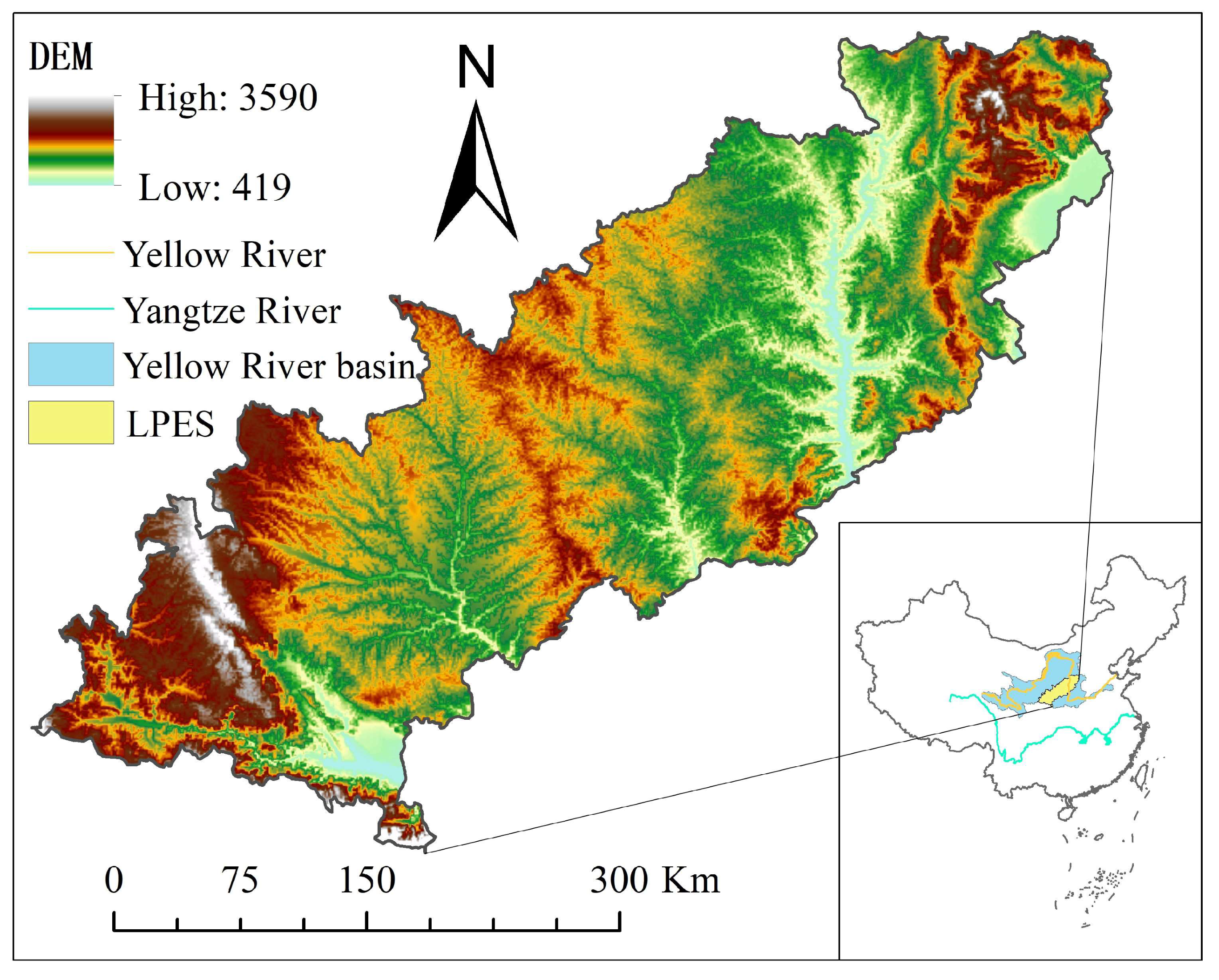
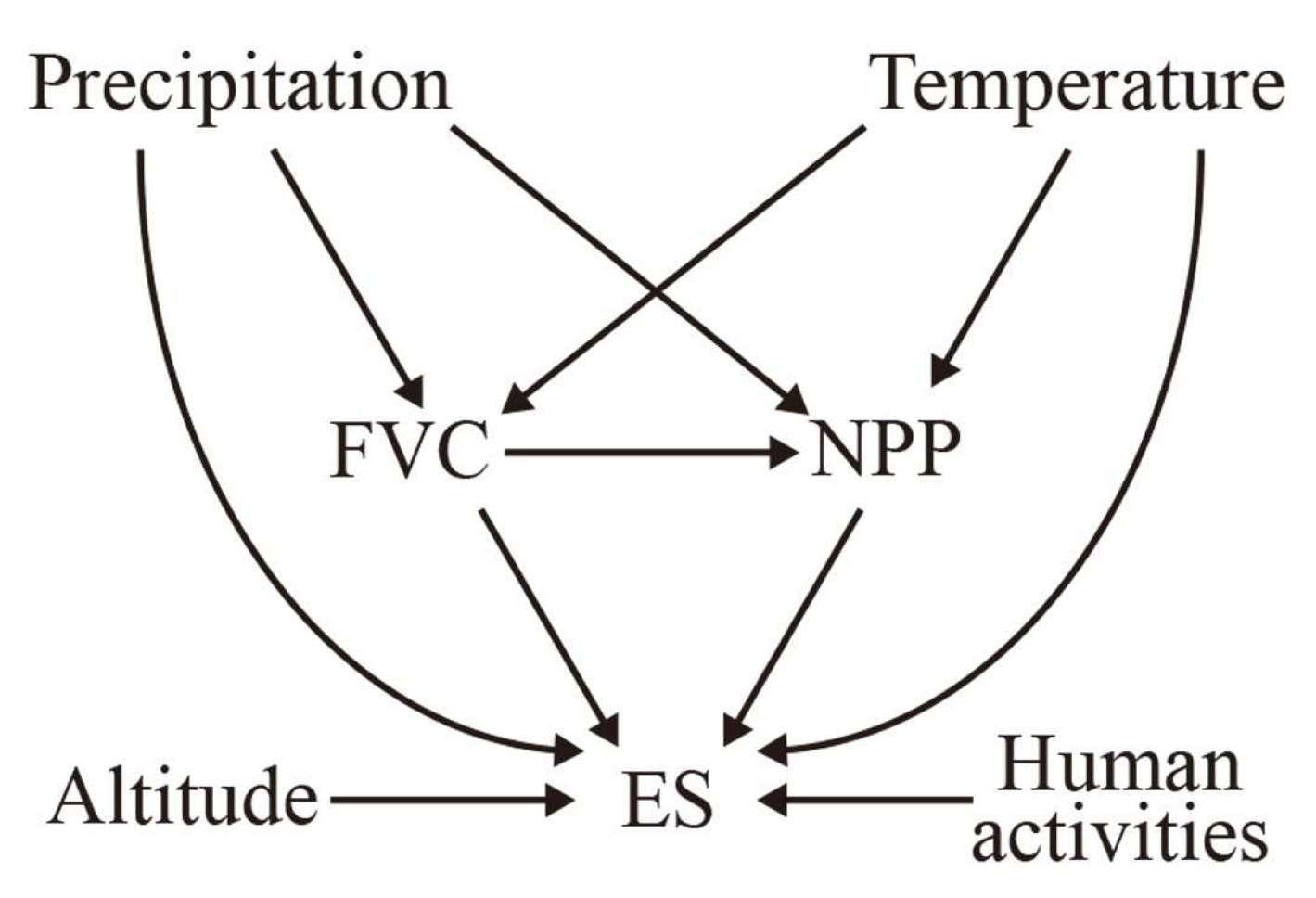
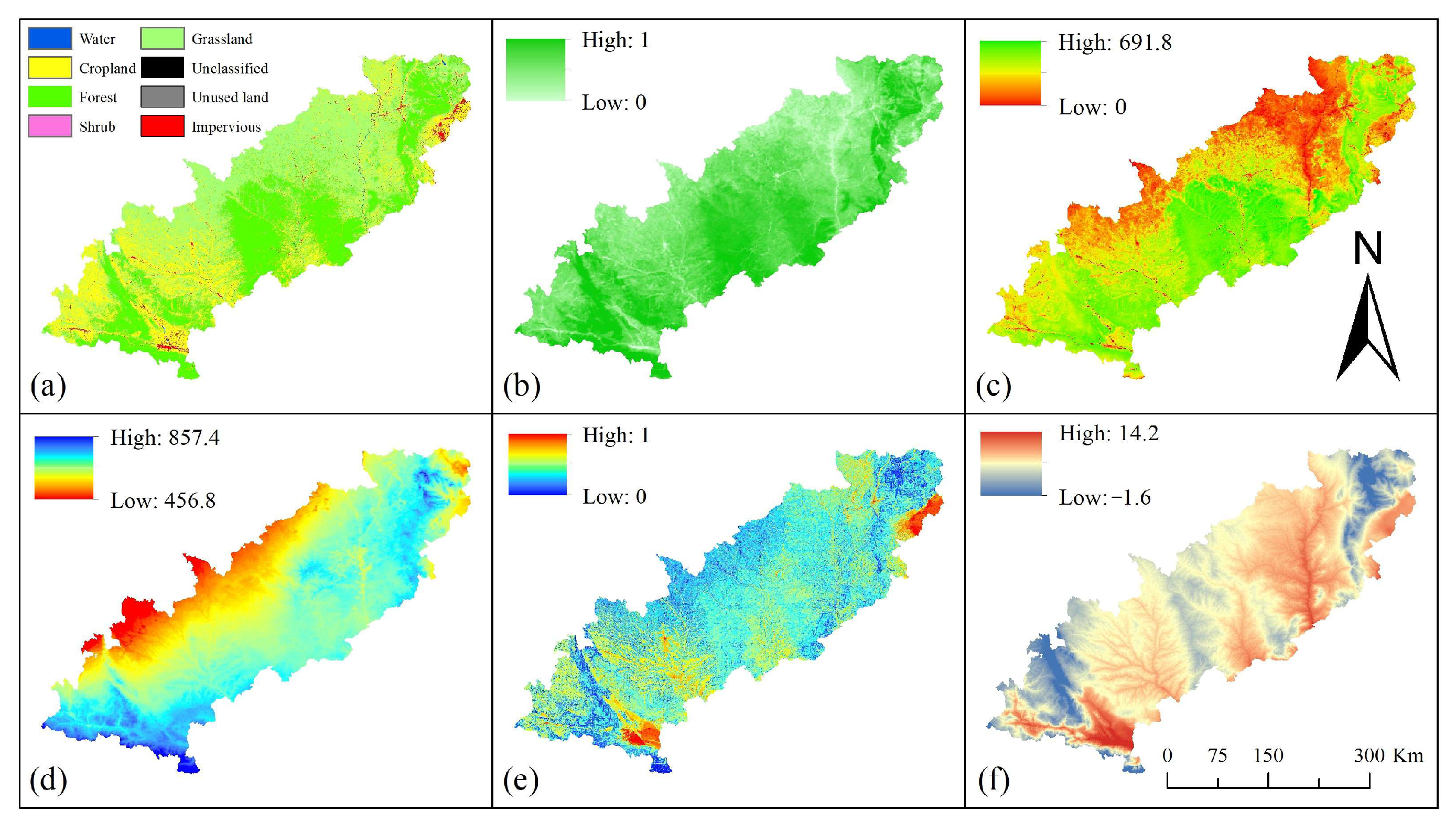
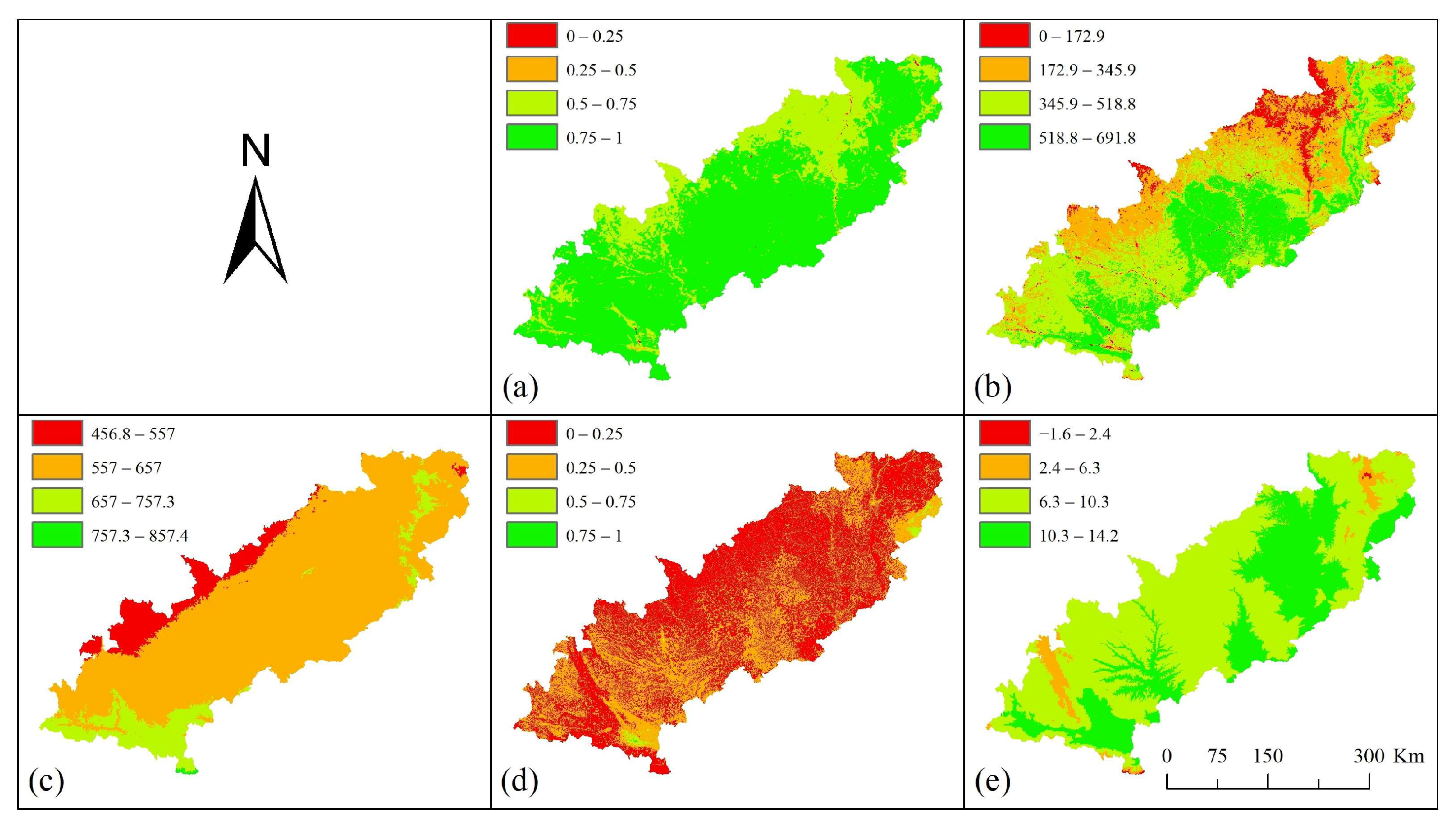
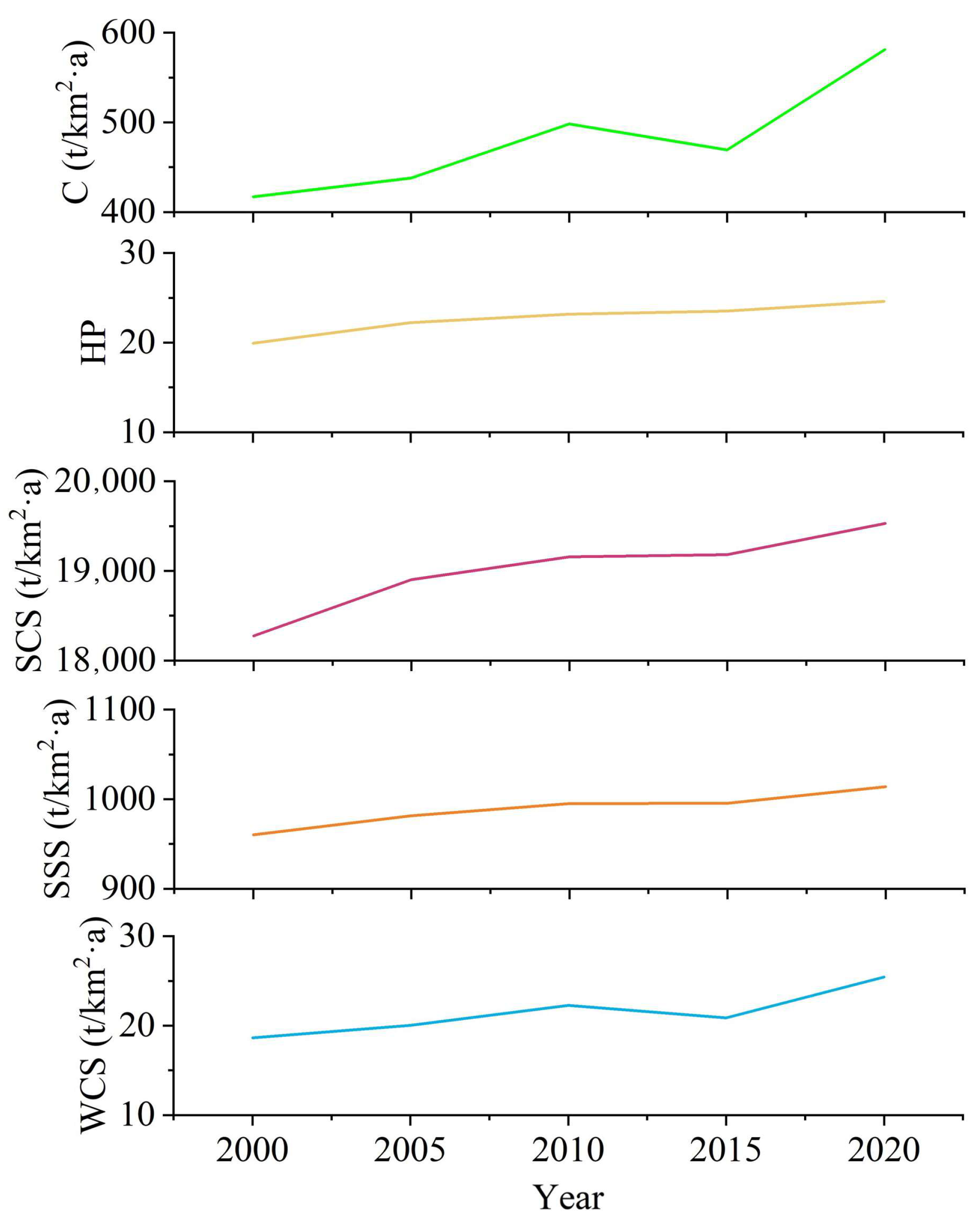
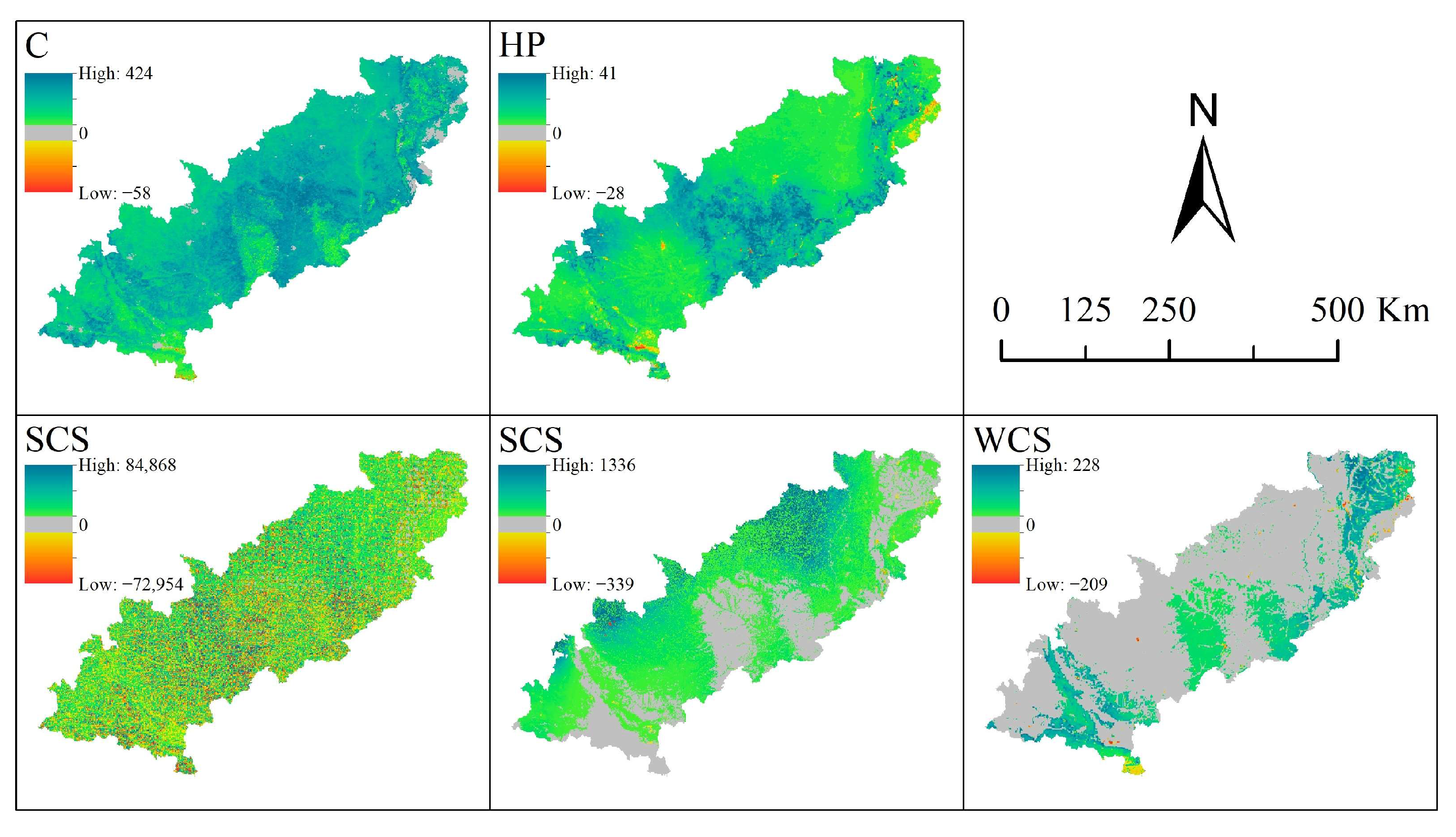


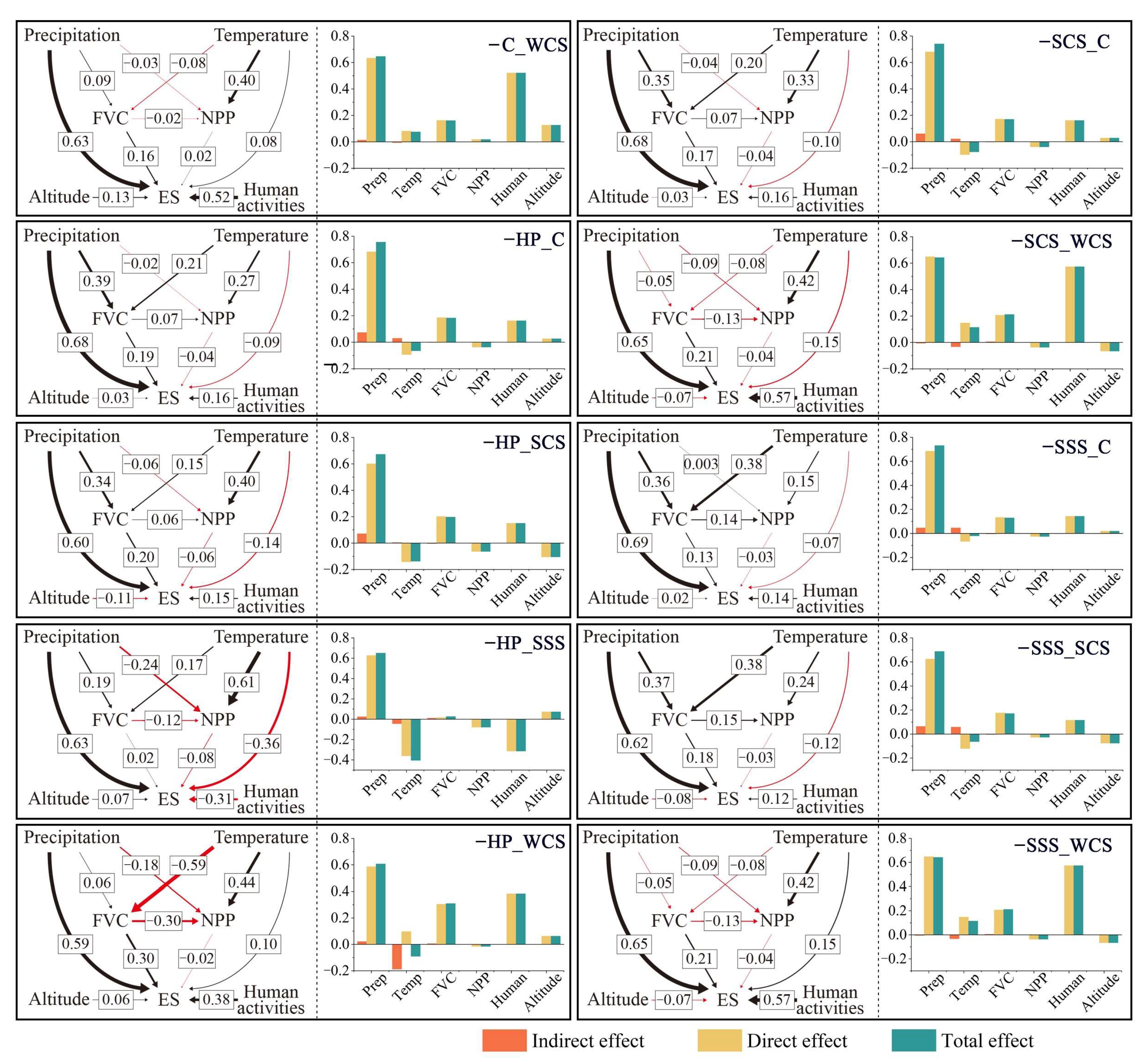
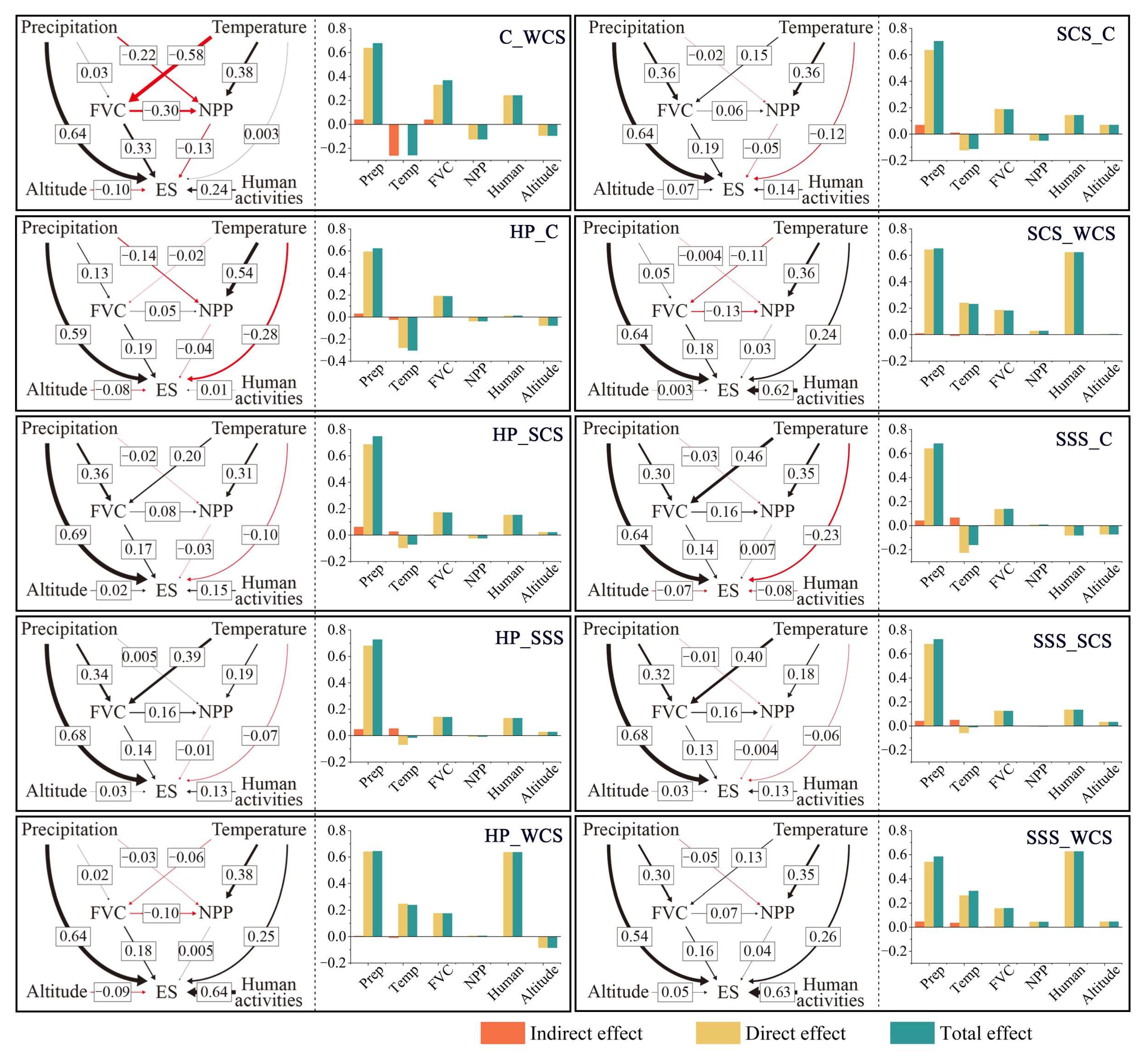
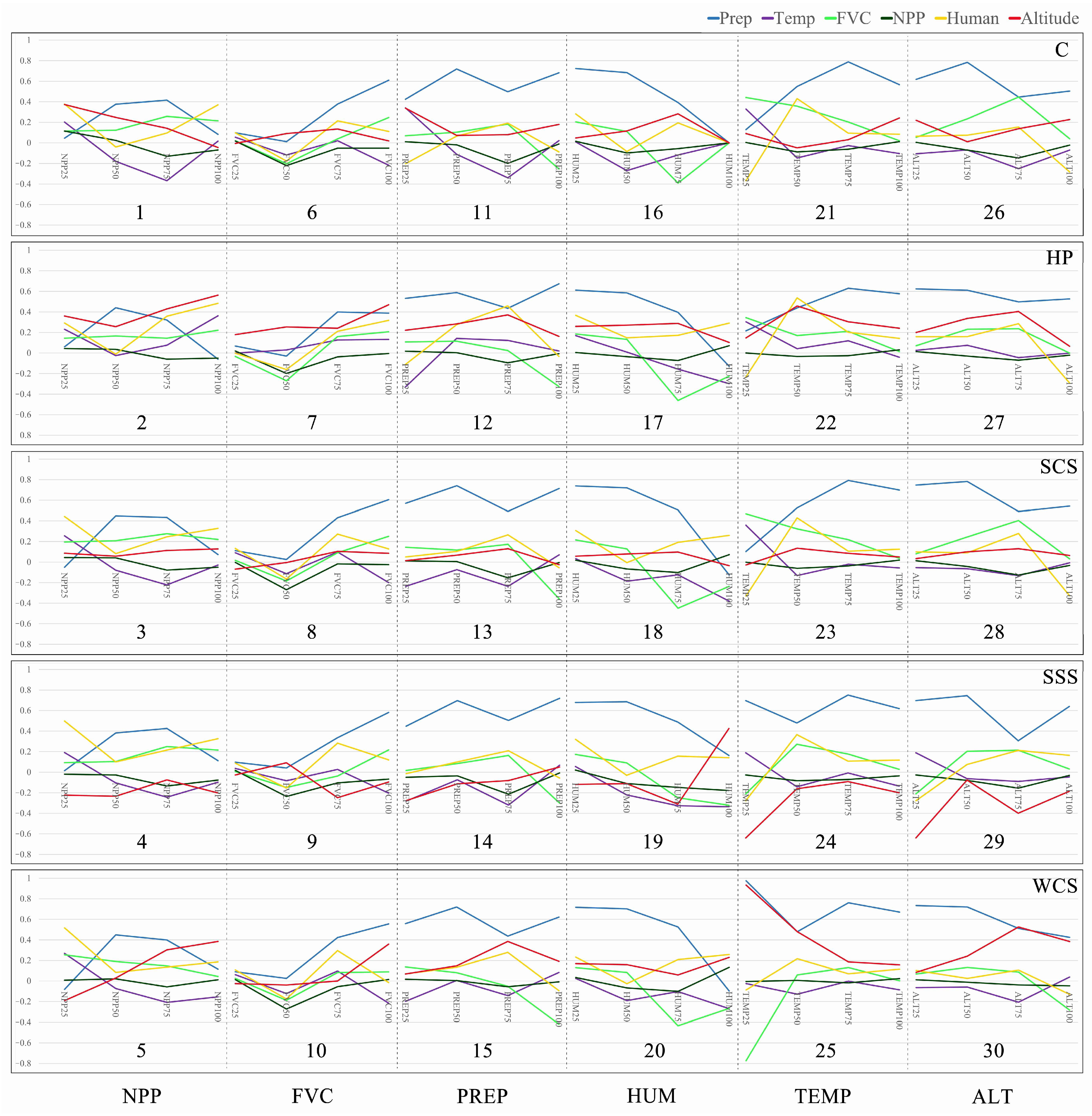
| Name of Data | Data Source | Website | Resolution |
|---|---|---|---|
| Meteorological data (relative humidity, hours of sunshine, wind direction, wind speed, etc.) | China Meteorological Data Service Center | http://data.cma.cn (accessed on 1 September 2022) | Meteorological station data |
| LULC (land use and land cover) data | Chinese Academy of Science Resource Environment Science and Data Center | https://www.resdc.cn (accessed on 12 September 2022) | 30 m |
| Population distribution data | 1000 m | ||
| Temperature, precipitation, and evapotranspiration data | National Earth System Science Data Center and Loess Plateau Sub-Center | http://loess.geodata.cn (accessed on 15 September 2022) | 1000 m |
| DEM (digital elevation model) data | Geospatial Data Cloud Site, Computer Network Information Center, and Chinese Academy of Sciences | http://www.gscloud.cn (accessed on 1 June 2022) | 30 m |
| FVC (fractional vegetation cover) data and NPP (net primary productivity) data | National Aeronautics and Space Administration | https://ladsweb.nascom.nasa.gov (accessed on 15 June 2022) | 250 m |
| Soil type data | National Soil Information Service Platform of China | http://www.soilinfo.cn (accessed on 10 June 2022 | 1000 m |
| Forest and Grassland Ecosystem Type | α |
|---|---|
| coniferous forest | 3.02 |
| mixed coniferous-broad forest | 2.29 |
| deciduous broad-leaved forest | 1.33 |
| sparse forest | 19.2 |
| evergreen broad-leaved scrub | 4.26 |
| deciduous broad-leaved scrub | 4.17 |
| open scrub | 19.2 |
| grassland | 4.78 |
| tussock | 9.37 |
| meadow | 8.2 |
| Evaluation Index Factors | Weights | Classification | Score |
|---|---|---|---|
| Altitude (m) | 0.1 | 419–800 | 100 |
| 800–1200 | 60 | ||
| 1200–1600 | 30 | ||
| >1600 | 10 | ||
| Undulation (m) | 0.1 | 0–60 | 100 |
| 60–120 | 80 | ||
| 120–180 | 50 | ||
| >180 | 10 | ||
| Slope (°) | 0.1 | 0–3° | 100 |
| 3–6° | 75 | ||
| 6–9° | 50 | ||
| >9° | 25 | ||
| LULC (land use andland cover) | 0.2 | Unclassified | 0 |
| Cropland | 80 | ||
| Forest | 40 | ||
| Shrubs | 20 | ||
| Grassland | 10 | ||
| Waters | 5 | ||
| Unused land | 0 | ||
| Impervious | 100 | ||
| Population density | 0.5 | 13–3222 people/Km2 | 13 people/Km2 0 3222 people/Km2 100 |
Disclaimer/Publisher’s Note: The statements, opinions and data contained in all publications are solely those of the individual author(s) and contributor(s) and not of MDPI and/or the editor(s). MDPI and/or the editor(s) disclaim responsibility for any injury to people or property resulting from any ideas, methods, instructions or products referred to in the content. |
© 2023 by the authors. Licensee MDPI, Basel, Switzerland. This article is an open access article distributed under the terms and conditions of the Creative Commons Attribution (CC BY) license (https://creativecommons.org/licenses/by/4.0/).
Share and Cite
Wei, C.; Zeng, J.; Wang, J.; Jiang, X.; You, Y.; Wang, L.; Zhang, Y.; Liao, Z.; Su, K. Assessing the Impact of Climate and Human Activities on Ecosystem Services in the Loess Plateau Ecological Screen, China. Remote Sens. 2023, 15, 4717. https://doi.org/10.3390/rs15194717
Wei C, Zeng J, Wang J, Jiang X, You Y, Wang L, Zhang Y, Liao Z, Su K. Assessing the Impact of Climate and Human Activities on Ecosystem Services in the Loess Plateau Ecological Screen, China. Remote Sensing. 2023; 15(19):4717. https://doi.org/10.3390/rs15194717
Chicago/Turabian StyleWei, Changwen, Jiaqin Zeng, Jiping Wang, Xuebing Jiang, Yongfa You, Luying Wang, Yiming Zhang, Zhihong Liao, and Kai Su. 2023. "Assessing the Impact of Climate and Human Activities on Ecosystem Services in the Loess Plateau Ecological Screen, China" Remote Sensing 15, no. 19: 4717. https://doi.org/10.3390/rs15194717
APA StyleWei, C., Zeng, J., Wang, J., Jiang, X., You, Y., Wang, L., Zhang, Y., Liao, Z., & Su, K. (2023). Assessing the Impact of Climate and Human Activities on Ecosystem Services in the Loess Plateau Ecological Screen, China. Remote Sensing, 15(19), 4717. https://doi.org/10.3390/rs15194717






